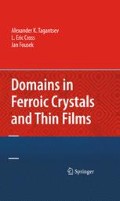Abstract
Splitting of a ferroic sample into domains strongly influences most of its averaged macroscopic properties. Thus by measuring these properties we can obtain indirect information about the representation of individual domain states; perhaps the simplest example is the magnitude of macroscopic polarization of a sample of a uniaxial ferroelectric crystal. In the present chapter we wish to give an overview of methods which lead to a more detailed knowledge about shapes and sizes of individual domains. The number of delineating techniques is large and continuously increases, the push behind this progress being improved spatial resolution, speed, and possibility to distinguish small domains from lattice defects which have no relation to the order parameter.
Access this chapter
Tax calculation will be finalised at checkout
Purchases are for personal use only
Notes
- 1.
The deformations of the sample surface due to d 31 and d 32 piezoelectric coefficients will not lead to any tip displacement as far as they are homogeneous in the region sensed by the electric field of the tip. In principle, these deformations may lead to tip displacements close to domain walls and grain boundaries.
- 2.
Having made this statement, one has to wonder why this was not done in the earliest stages of investigations of crystalline plates of Rochelle salt—in particular when dielectric hysteresis was discovered (Valasek, 1921). The more so, that later Valasek demonstrated his very high level in optics by many papers, as well as by his valuable book Introduction to Theoretical and Experimental Optics (John Wiley & Sons, 1960). Perhaps lack of equipment, or preparation of sample surfaces ….... By performing such observations, ferroelectrics could have “beaten” ferromagnetics by 10 years (Fousek, 1994).
- 3.
NSOM is also used as abbreviation.
- 4.
Abbreviation ANSOM is also in use.
- 5.
Interestingly enough, in both cases it was found that the relative volumes of the three ferroelastic domain states differ substantially well below the transition temperature but approach 1/3 close to the transition temperature.
Author information
Authors and Affiliations
Corresponding author
Rights and permissions
Copyright information
© 2010 Springer Science+Business Media, LLC
About this chapter
Cite this chapter
Tagantsev, A.K., Cross, L.E., Fousek, J. (2010). Methods for Observation of Domains. In: Domains in Ferroic Crystals and Thin Films. Springer, New York, NY. https://doi.org/10.1007/978-1-4419-1417-0_4
Download citation
DOI: https://doi.org/10.1007/978-1-4419-1417-0_4
Published:
Publisher Name: Springer, New York, NY
Print ISBN: 978-1-4419-1416-3
Online ISBN: 978-1-4419-1417-0
eBook Packages: Physics and AstronomyPhysics and Astronomy (R0)

